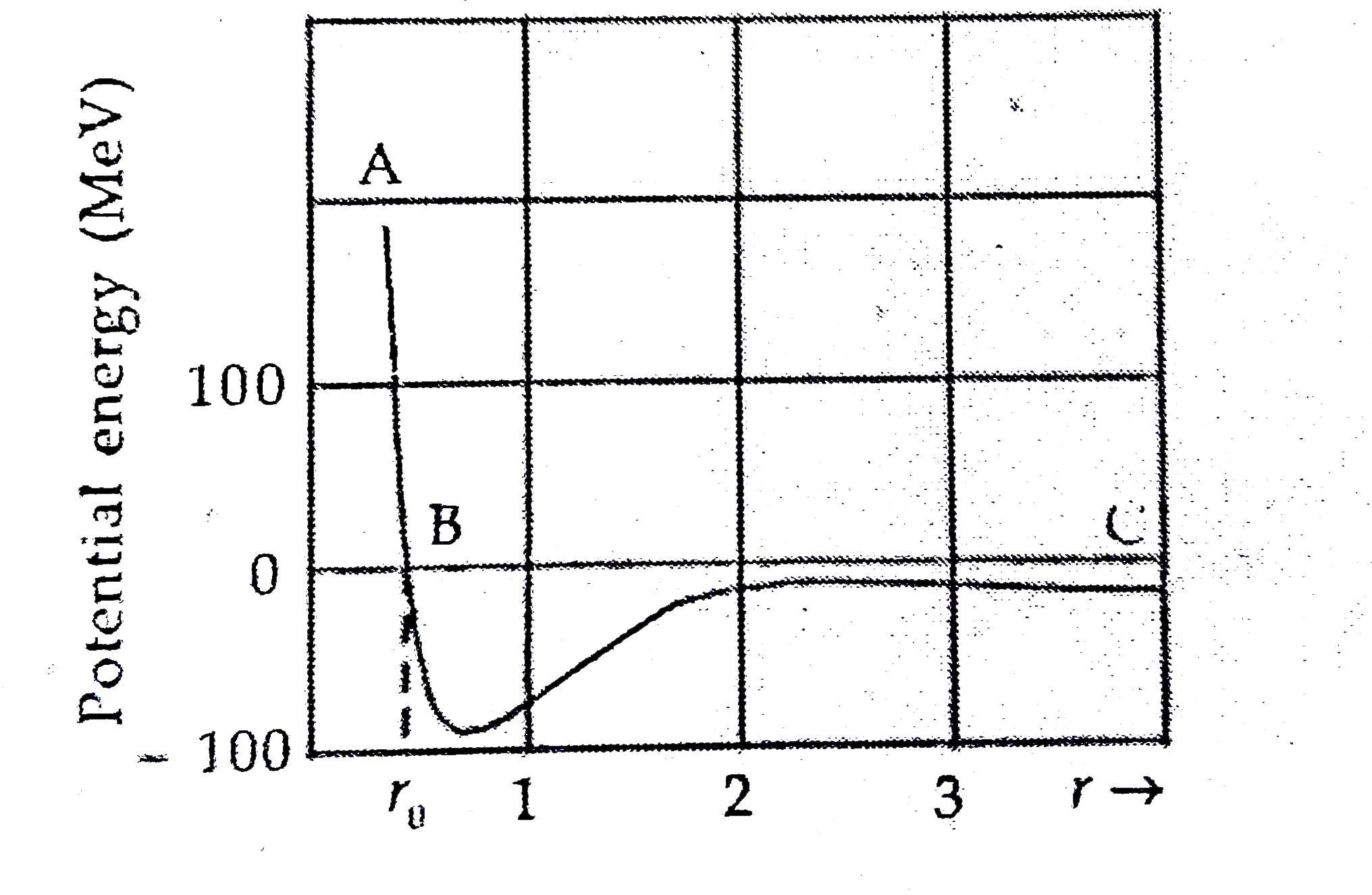(a) In a nuclear reaction MeV, though the number of nucleons is conserved on both sides of the reaction, yet the energy is released. How? Explain.
(b) Draw a plot of potential energy between a pair of nucleons as a function of their separation. Mark the regions where potential energy is (i) positive and (ii) negative.
(a) In a nuclear reaction, the sum of the masses of the target nuclues and the bombarding particle may be greater or less the sum of the masses of the product nucleus and the . So from the law of conservation of mass energy some energy some energy (12.86 MeV) is envolved in nuclear reaction . This energy is called Q-value of the nuclear reaction . The binding energy of the nucleus on the left side is not equal to the right side. The difference in the binding energies on two sides appears as energy released or absorbed in the nuclear reaction.
(b) The potential energy is minimum at . For distances larger than the negative potential energy goes on decreasing and for the distances less than the negative potential energy decreases to zero and then becomes positive and increases abruptly. Thus, A to B is the positive potential energy region and B to C is the negative potential energy region.

Topper's Solved these Questions
- BOOK - XII BOARDS PREVIOUS YEARCHAPTER - XII BOARDSEXERCISE - [SET - I]32videos
XII BOARDS
- BOOK - XII BOARDS PREVIOUS YEARCHAPTER - XII BOARDSEXERCISE - [SET - II DELHI BOARD]6videos
XII BOARDS
- BOOK - XII BOARDS PREVIOUS YEARCHAPTER - XII BOARDSEXERCISE - SET - II (Delhi Board)8videos
XII BOARDS
- BOOK - XII BOARDS PREVIOUS YEARCHAPTER - SAMPLE PAPER 2019EXERCISE - SECTION D6videos
SAMPLE PAPER 2019
Similar Questions
Draw a plot of potential energy of a pair of nucleons as a function of their separation. What is the significance of negative potential energy in the graph drawn ?
View SolutionDraw a graph showing the variation of potential energy between a pair of nucleons as a function of their separation. Indicate the regions in which the nuclear force is (i) attractive, (ii) repulsive.
View Solution
Knowledge Check
- Question 1 - Select One
The nuclear reaction .21H+.21H→.42He is called
Afission reactionBfusion reactionCchain reactionDthermal reaction
(a) Draw a plot showing the variation of potential energy of a pair of nucleons as a function of their separation . Mark the regions where the nuclear force is :
(i) attractive and (ii) repulsive.
(b) In the nuclear reaction
n+235U→92aXe+54 94Sr+2nb determine the values of a and b .View SolutionDraw a plot of potential energy of a pair of nucleons as a function of their separation . Write two important conclusions which you can draw regarding the nature of nuclear forces .
View SolutionDraw a plot of potential energy of a pair of nucleons as a function of their separation. Write two important conclusions which you can draw regarding the nature of nuclear forces.
View Solution(a) In a typical nuclear reaction, e.g.,
21H+ 21H→ 32He+n+3.27MeV,
although number of nucleons is conserved, yet energy is released. How ? Explain.
(b) Show that nuclear density in a given nucleus is independent of mass number A.View SolutionIn a typical unclear reaction, e.g.
21H+21H→32He+n+3.27MeV,
although number of nucleons is conserved is conserved, yet energy is released. How ? Explain.
(b) Show that nuclear dendity in a given nucleus is independent of mass number A.View SolutionDraw a graph between potential energy of a pair of nucleons and separation between them. Also write its main features.
View SolutionDraw a graph between potential energy of a pair of nucleons and separation between them. Also write its main features.
View Solution

